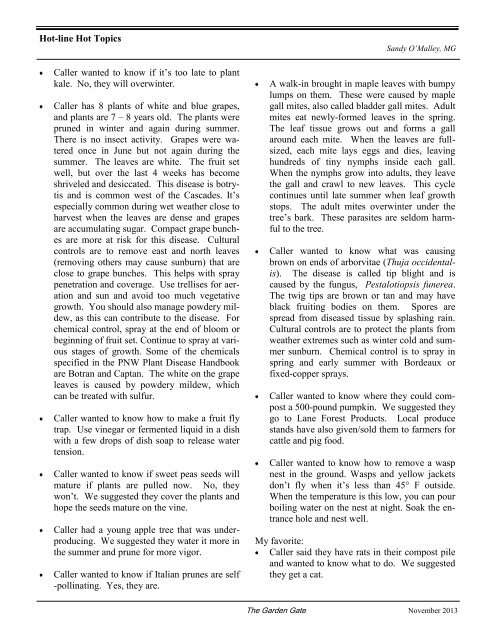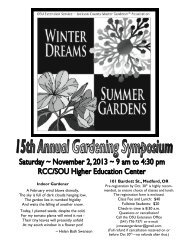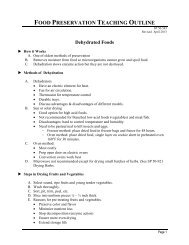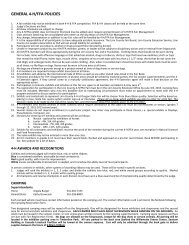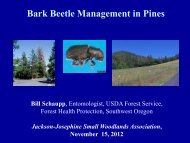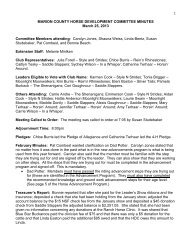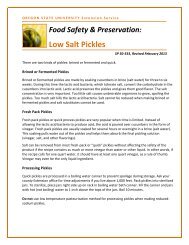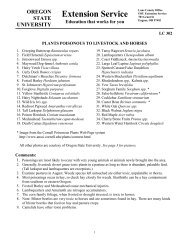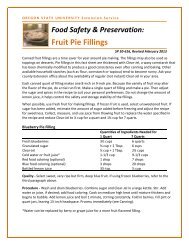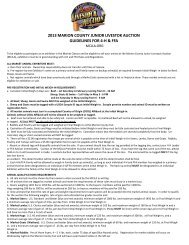November - Oregon State University Extension Service
November - Oregon State University Extension Service
November - Oregon State University Extension Service
You also want an ePaper? Increase the reach of your titles
YUMPU automatically turns print PDFs into web optimized ePapers that Google loves.
Hot-line Hot Topics<br />
Caller wanted to know if it’s too late to plant<br />
kale. No, they will overwinter.<br />
Caller has 8 plants of white and blue grapes,<br />
and plants are 7 – 8 years old. The plants were<br />
pruned in winter and again during summer.<br />
There is no insect activity. Grapes were watered<br />
once in June but not again during the<br />
summer. The leaves are white. The fruit set<br />
well, but over the last 4 weeks has become<br />
shriveled and desiccated. This disease is botrytis<br />
and is common west of the Cascades. It’s<br />
especially common during wet weather close to<br />
harvest when the leaves are dense and grapes<br />
are accumulating sugar. Compact grape bunches<br />
are more at risk for this disease. Cultural<br />
controls are to remove east and north leaves<br />
(removing others may cause sunburn) that are<br />
close to grape bunches. This helps with spray<br />
penetration and coverage. Use trellises for aeration<br />
and sun and avoid too much vegetative<br />
growth. You should also manage powdery mildew,<br />
as this can contribute to the disease. For<br />
chemical control, spray at the end of bloom or<br />
beginning of fruit set. Continue to spray at various<br />
stages of growth. Some of the chemicals<br />
specified in the PNW Plant Disease Handbook<br />
are Botran and Captan. The white on the grape<br />
leaves is caused by powdery mildew, which<br />
can be treated with sulfur.<br />
Caller wanted to know how to make a fruit fly<br />
trap. Use vinegar or fermented liquid in a dish<br />
with a few drops of dish soap to release water<br />
tension.<br />
Caller wanted to know if sweet peas seeds will<br />
mature if plants are pulled now. No, they<br />
won’t. We suggested they cover the plants and<br />
hope the seeds mature on the vine.<br />
Caller had a young apple tree that was underproducing.<br />
We suggested they water it more in<br />
the summer and prune for more vigor.<br />
Caller wanted to know if Italian prunes are self<br />
-pollinating. Yes, they are.<br />
Sandy O’Malley, MG<br />
A walk-in brought in maple leaves with bumpy<br />
lumps on them. These were caused by maple<br />
gall mites, also called bladder gall mites. Adult<br />
mites eat newly-formed leaves in the spring.<br />
The leaf tissue grows out and forms a gall<br />
around each mite. When the leaves are fullsized,<br />
each mite lays eggs and dies, leaving<br />
hundreds of tiny nymphs inside each gall.<br />
When the nymphs grow into adults, they leave<br />
the gall and crawl to new leaves. This cycle<br />
continues until late summer when leaf growth<br />
stops. The adult mites overwinter under the<br />
tree’s bark. These parasites are seldom harmful<br />
to the tree.<br />
Caller wanted to know what was causing<br />
brown on ends of arborvitae (Thuja occidentalis).<br />
The disease is called tip blight and is<br />
caused by the fungus, Pestalotiopsis funerea.<br />
The twig tips are brown or tan and may have<br />
black fruiting bodies on them. Spores are<br />
spread from diseased tissue by splashing rain.<br />
Cultural controls are to protect the plants from<br />
weather extremes such as winter cold and summer<br />
sunburn. Chemical control is to spray in<br />
spring and early summer with Bordeaux or<br />
fixed-copper sprays.<br />
Caller wanted to know where they could compost<br />
a 500-pound pumpkin. We suggested they<br />
go to Lane Forest Products. Local produce<br />
stands have also given/sold them to farmers for<br />
cattle and pig food.<br />
Caller wanted to know how to remove a wasp<br />
nest in the ground. Wasps and yellow jackets<br />
don’t fly when it’s less than 45° F outside.<br />
When the temperature is this low, you can pour<br />
boiling water on the nest at night. Soak the entrance<br />
hole and nest well.<br />
My favorite:<br />
Caller said they have rats in their compost pile<br />
and wanted to know what to do. We suggested<br />
they get a cat.<br />
The Garden Gate <strong>November</strong> 2013


